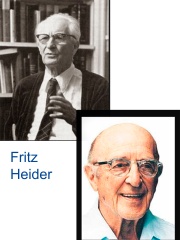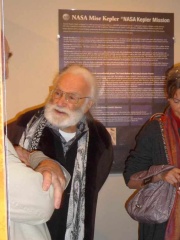
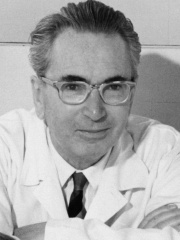
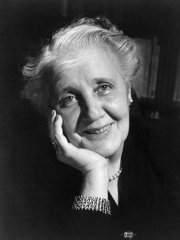
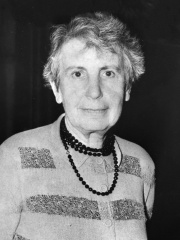
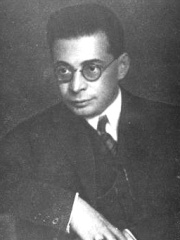
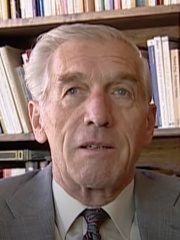

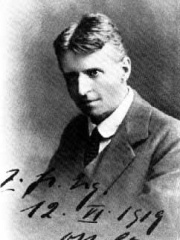
The Most Famous
PSYCHOLOGISTS from Austria
This page contains a list of the greatest Austrian Psychologists. The pantheon dataset contains 183 Psychologists, 14 of which were born in Austria. This makes Austria the birth place of the 4th most number of Psychologists behind Germany and United Kingdom.
Top 10
The following people are considered by Pantheon to be the top 10 most legendary Austrian Psychologists of all time. This list of famous Austrian Psychologists is sorted by HPI (Historical Popularity Index), a metric that aggregates information on a biography’s online popularity. Visit the rankings page to view the entire list of Austrian Psychologists.

1. Alfred Adler (1870 - 1937)
With an HPI of 78.40, Alfred Adler is the most famous Austrian Psychologist. His biography has been translated into 74 different languages on wikipedia.
Alfred Adler ( AD-lər, German: [ˈalfʁeːt ˈʔaːdlɐ]; 7 February 1870 – 28 May 1937) was an Austrian medical doctor, psychotherapist, and founder of the school of individual psychology. His emphasis on the importance of feelings of belonging, relationships within the family, and birth order set him apart from Freud and others in their common circle. He proposed that contributing to others (social interest or Gemeinschaftsgefühl) was how the individual feels a sense of worth and belonging in the family and society. His earlier work focused on inferiority, coining the term inferiority complex, an isolating element which he argued plays a key role in personality development. Alfred Adler considered a human being as an individual whole, and therefore he called his school of psychology "Individual Psychology". Adler was the first to emphasize the importance of the social element in the re-adjustment process of the individual and to carry psychiatry into the community. A Review of General Psychology survey, published in 2002, ranked Adler as the 67th most eminent psychologist of the 20th century.

2. Viktor Frankl (1905 - 1997)
With an HPI of 74.55, Viktor Frankl is the 2nd most famous Austrian Psychologist. His biography has been translated into 53 different languages.
Viktor Emil Frankl (26 March 1905 – 2 September 1997) was an Austrian psychiatrist and Holocaust survivor, who founded logotherapy, a school of psychotherapy that describes a search for a life's meaning as the central human motivational force. Logotherapy is part of existential and humanistic psychology theories. Logotherapy was promoted as the third school of Viennese Psychotherapy, after those established by Sigmund Freud, and Alfred Adler. Frankl published 39 books. The autobiographical Man's Search for Meaning, a best-selling book, is based on his experiences in various Nazi concentration camps.

3. Melanie Klein (1882 - 1960)
With an HPI of 70.95, Melanie Klein is the 3rd most famous Austrian Psychologist. Her biography has been translated into 43 different languages.
Melanie Klein (née Reizes; 30 March 1882 – 22 September 1960) was an Austrian-British author and psychoanalyst known for her work in child analysis. She was the primary figure in the development of object relations theory. Klein suggested that pre-verbal existential anxiety in infancy catalyzed the formation of the unconscious, which resulted in the unconscious splitting of the world into good and bad idealizations. In her theory, how the child resolves that split depends on the constitution of the child and the character of nurturing the child experiences. The quality of resolution can inform the presence, absence, and/or type of distresses a person experiences later in life.

4. Anna Freud (1895 - 1982)
With an HPI of 70.72, Anna Freud is the 4th most famous Austrian Psychologist. Her biography has been translated into 50 different languages.
Anna Freud CBE (3 December 1895 – 9 October 1982) was a British psychoanalyst of Austrian–Jewish descent. She was born in Vienna, the sixth and youngest child of Sigmund Freud and Martha Bernays. She followed the path of her father and contributed to the field of psychoanalysis. Alongside Hermine Hug-Hellmuth and Melanie Klein, she may be considered the founder of psychoanalytic child psychology. Compared to her father, her work emphasized the importance of the ego and its normal "developmental lines" as well as incorporating a distinctive emphasis on collaborative work across a range of analytical and observational contexts. After the Freud family were forced to leave Vienna in 1938 with the advent of the Nazi regime in Austria, she resumed her psychoanalytic practice and her pioneering work in child psychoanalysis in London, establishing the Hampstead Child Therapy Course and Clinic in 1952 (now the Anna Freud National Centre for Children and Families) as a centre for therapy, training and research work.

5. Bruno Bettelheim (1903 - 1990)
With an HPI of 62.19, Bruno Bettelheim is the 5th most famous Austrian Psychologist. His biography has been translated into 28 different languages.
Bruno Bettelheim (August 28, 1903 – March 13, 1990) was an Austrian-born psychologist, scholar, public intellectual and writer who spent most of his academic and clinical career in the United States. An early writer on autism, Bettelheim's work focused on the education of emotionally disturbed children, as well as Freudian psychology more generally. In the U.S., he later gained a position as professor at the University of Chicago and director of the Sonia Shankman Orthogenic School for Disturbed Children, and after 1973 taught at Stanford University. Bettelheim's ideas, which grew out of those of Sigmund Freud, theorized that children with behavioral and emotional disorders were not born that way, and could be treated through extended psychoanalytic therapy, treatment that rejected the use of psychotropic drugs and shock therapy. During the 1960s and 1970s he had an international reputation in such fields as autism, child psychiatry, and psychoanalysis. Some of his work was discredited after his death due to fraudulent academic credentials, allegations of patient abuse, accusations of plagiarism, and lack of oversight by institutions and the psychological community.

6. Otto Rank (1884 - 1939)
With an HPI of 61.51, Otto Rank is the 6th most famous Austrian Psychologist. His biography has been translated into 40 different languages.
Otto Rank (; German: [ʀaŋk]; né Rosenfeld; 22 April 1884 – 31 October 1939) was an Austrian psychoanalyst, writer, and philosopher. Born in Vienna, he was one of Sigmund Freud's closest colleagues for 20 years, a prolific writer on psychoanalytic themes, editor of the two leading analytic journals of the era, managing director of Freud's publishing house, and a creative theorist and therapist. In 1926, Rank left Vienna for Paris and, for the remainder of his life, led a successful career as a lecturer, writer, and therapist in France and the United States.

7. Paul Watzlawick (1921 - 2007)
With an HPI of 60.60, Paul Watzlawick is the 7th most famous Austrian Psychologist. His biography has been translated into 22 different languages.
Paul Watzlawick (July 25, 1921 – March 31, 2007) was an Austrian-American family therapist, psychologist, communication theorist, and philosopher. A theoretician in communication theory and radical constructivism, he commented in the fields of family therapy and general psychotherapy. Watzlawick believed that people create their own suffering in the very act of trying to fix their emotional problems. He was one of the most influential figures at the Mental Research Institute and lived and worked in Palo Alto, California.

8. René Spitz (1887 - 1974)
With an HPI of 58.58, René Spitz is the 8th most famous Austrian Psychologist. His biography has been translated into 15 different languages.
René Árpád Spitz (January 29, 1887 in Vienna – September 14, 1974 in Denver) was an Austrian-American psychoanalyst. He is best known for his analysis of hospitalized infants in which he found links between marasmus and death with unmothered infants. Spitz also made significant contributions to the school of ego psychology.

9. Otto Gross (1877 - 1920)
With an HPI of 58.29, Otto Gross is the 9th most famous Austrian Psychologist. His biography has been translated into 19 different languages.
Otto Hans Adolf Gross (17 March 1877 – 13 February 1920) was an Austrian psychoanalyst. A maverick early disciple of Sigmund Freud, he later became an anarchist and joined the utopian Ascona community. His father Hans Gross was a judge turned pioneering criminologist. Otto initially collaborated with him, and then turned against his determinist ideas on character. A champion of an early form of anti-psychiatry and sexual liberation, he also developed an anarchist form of depth psychology (which rejected the civilising necessity of psychological repression proposed by Freud). He adopted a modified form of the proto-feminist and neo-pagan theories of Johann Jakob Bachofen, with which he attempted to return civilization to a 'golden age' of non-hierarchy. Gross was ostracized from the larger psychoanalytic movement, and was not included in histories of the psychoanalytic and psychiatric establishments. He died in poverty. Greatly influenced by the philosophy of Max Stirner and Friedrich Nietzsche and the political theories of Peter Kropotkin, he in turn influenced D. H. Lawrence (through Gross's affair with Frieda von Richthofen), Franz Kafka and other artists, including Franz Jung and other founders of Berlin Dada. His influence on psychology was more limited. Carl Jung claimed his entire worldview changed when he attempted to analyse Gross and partially had the tables turned on him. He became addicted to drugs in South America where he served as a naval doctor. He was hospitalized several times for drug addiction, sometimes losing his guardianship of himself to his father in the process. As a Bohemian drug user from youth, as well as an advocate of free love, he is sometimes credited as a founding grandfather of 20th-century counterculture.
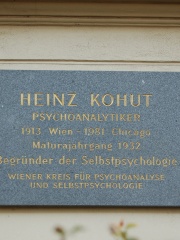
10. Heinz Kohut (1913 - 1981)
With an HPI of 57.85, Heinz Kohut is the 10th most famous Austrian Psychologist. His biography has been translated into 19 different languages.
Heinz Kohut (May 3, 1913 – October 8, 1981) was an Austrian-born American psychoanalyst best known for his development of self psychology, an influential school of thought within psychodynamic/psychoanalytic theory which helped transform the modern practice of analytic and dynamic treatment approaches.
Pantheon has 14 people classified as psychologists born between 1865 and 1930. Of these 14, none of them are still alive today. The most famous deceased psychologists include Alfred Adler, Viktor Frankl, and Melanie Klein. As of April 2022, 1 new psychologists have been added to Pantheon including Karl H. Pribram.
Deceased Psychologists
Go to all Rankings
Alfred Adler
1870 - 1937
HPI: 78.40
Viktor Frankl
1905 - 1997
HPI: 74.55
Melanie Klein
1882 - 1960
HPI: 70.95
Anna Freud
1895 - 1982
HPI: 70.72
Bruno Bettelheim
1903 - 1990
HPI: 62.19
Otto Rank
1884 - 1939
HPI: 61.51
Paul Watzlawick
1921 - 2007
HPI: 60.60
René Spitz
1887 - 1974
HPI: 58.58
Otto Gross
1877 - 1920
HPI: 58.29
Heinz Kohut
1913 - 1981
HPI: 57.85
Walter Mischel
1930 - 2018
HPI: 54.16
Fritz Heider
1896 - 1988
HPI: 53.45

Newly Added Psychologists (2022)
Go to all RankingsWhich Psychologists were alive at the same time? This visualization shows the lifespans of the 14 most globally memorable Psychologists since 1700.


